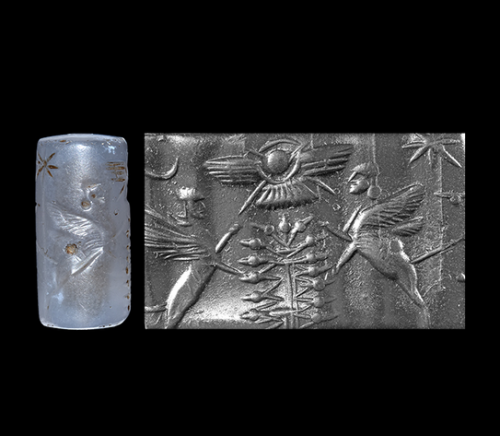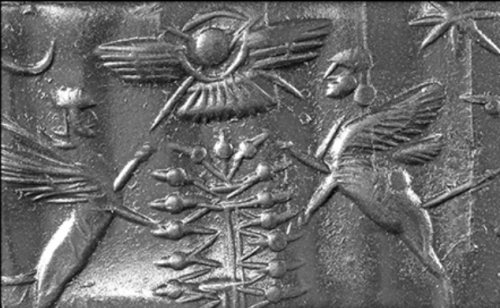#cylinder seal

A cylinder seal from the ancient Dynastic Period (2600-2350 BCE), found in Khafajeh, Iraq. For the pixel daily theme ‚seal‘. 100x100px.
“Your Cup is Full”. Study for a Minoan cylinder seal impression*, 2012/2017
Acrylics on prepaped paper, 13.7 x 18.5 cm
Last month I had a dream involving an old memory exercise – the blind study of an ancient Minoan cylinder seal impression painted back in 2012.
In my dream I return to the studio after a walk and realize I have a guest: someone is shuffling through drawings in complete darkness! I switch the light on and find myself standing in the middle of a subterranean place of worship. In front of me there’s a Persian girl examining my drawings scattered on the floor among oddly shaped (votive?) coins and gemstones. After a while she pulls this old sheet of studies, nods thoughtfully and cuts the seal impression out of it with scissors. She inspects the painting again before producing a qalam from the folds of her colourful hide and writing something just above the grotesque griffin figure. She then hands the sheet over to me with a lovely smile. To my surprise the tiny piece of paper weighs like an apple; the Farsi calligraphy reads “Your cup is full”. I reach out to touch the writing but my hand meets with an obstacle - there’s an invisible object sitting on the surface of the study!
Upon awakening I promptly pulled the sheet from the heap, cut out the impression, brought it as close to the dream version as I could and added the gilded calligraphy. Now haunted by the memory of the invisible object I can’t help touching the writing every now and then fully expecting the phantom barrier to block my finger.
*unavailable
Post link
Neo-Babylonian Cylinder Seal with Rampant Sphinxes, 7th-6th Century BC
Made of chalcedony, with opposed rampant sphinxes flanking a stylized “Tree of Life” with a winged sun-disc above, along with an eight-pointed star and crescent moon.
In Mesopotamian mythology, a crescent is a symbol of the moon god, Sin, while the eight-pointed star representsIshtar, the goddess of love and war. The winged solar disc symbolizes Shamash, the sun god. The winged human-headed animals portrayed here are referred to as “sphinxes.” They were a common motif in Mesopotamian art and are considered to be guardian type entities. The meaning of the stylized “tree of life” is still unknown and a much debated subject.
Post link



